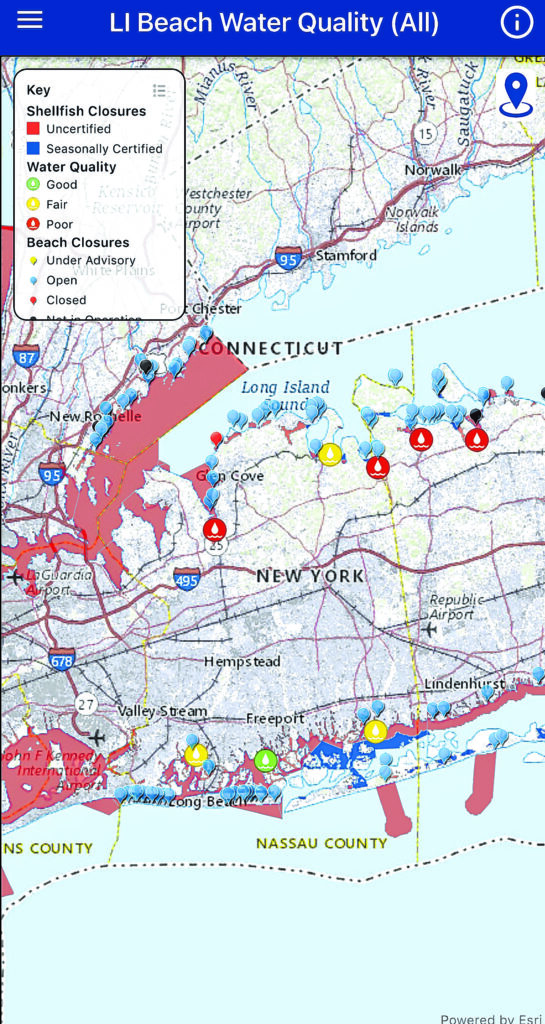Tips on how to stay safe
By Sia Han and Ethan Brown
Air quality in New York reached historically bad levels this summer, with New York City being ranked as the worst polluted major city in the world on June 7.
Quinn Kweit, a rising senior at Jericho High School, remembers looking out the classroom windows that Wednesday and seeing an orange sky. “At school the hallways smelled like smoke and it made me nauseous and light-headed. I thought I was going to pass out.”
New Yorkers were advised to “limit outdoor activity to the greatest extent possible,” in a statement by NYC Mayor Eric Adams.

The Environmental Protection Agency measures levels of ozone and particulates to determine air quality. Ozone is generated by automobile exhaust, which produces smog, and is particularly prevalent in areas with lots of automobile traffic and hot weather.
But the majority of the air pollution this summer has been particulate pollution, also called particulate matter (PM), which consists of very fine particles generated from the burning of matter. Record high temperatures this summer have exacerbated Canada’s wildfire season, bringing dryer and hotter climates and an earlier start to the wildfire season.
The resulting smoke led to dangerous air quality in New York City and surrounding areas.
According to Norman Edelman, M.D. Professor of Medicine at Stony Brook University, particulate pollution directly affects the heart and causes irritation of the lungs. Short-term effects include inflammation of the airways, coughing, pressure in the chest, and runny eyes. Long-term exposure to PM “is a risk factor for lung cancer… and chronic lung disease called COPD (Chronic Obstructive Pulmonary Disease).”
A link between higher levels of PM and greater reports of heart attacks has also been noted.
Those with heart disease and pulmonary artery disease are especially susceptible to air pollution, says Edelman. “People who are debilitated with other illnesses, whether they’re elderly or whether they’re immunocompromised, should also take special precautions.”
Edelman mainly advises that in the case of high PM levels, people should avoid spending time outdoors, particularly those with lung problems like asthma.
The Air Quality Index, which can be found on the NYS Department of Environmental Conservation’s website https://www.dec.ny.gov/index.html, can be checked for daily air reports.

(Screenshot via LI Beach Water Quality app)
When the index goes over 100 or 150, at-risk people should stay indoors as much as possible, while others should take extra precautions.
Edelman recommends filtering air while staying indoors, either by running air conditioners or using high efficiency particulate air (HEPA) filters. Masks can also be useful however, “you can’t rely on them to make you safe,” as they fail to filter out smaller particles. The most effective masks are the N95 and KN95.
Currently, the air quality on Long Island has improved and mainly stabilized compared to levels in early June, due to prevailing winds that have not blown ash in this direction and rainy, overcast days. However, as wildfires continue to rage on in Canada and temperatures this summer continue to rise, it is in residents’ best interest to remain aware of changes in the AQI and what safety precautions to take.
Beaches across Long Island have been issued health advisory warnings due to poor water quality.
After heavy rainfall, bacterial levels are typically raised and harmful substances can enter waterways. In response, the Department of Health has advised residents to avoid entering the water in beaches. They asked the public to stay away from certain beaches for about a day following rainfall.
In their Aug. 15 press release, the Department of Health named 14 North Shore beaches and 4 South Shore as potentially having poor water quality; they asked residents to forgo their beach trips there. Alyssa Zohrabian from the Department of Health said, “This is an advisory against bathing because heavy rainfall in some beaches is known to impact water quality.”
While the Department of Health lifts the advisories for a day following rainfall, an overall decline in Long Island’s water quality has been occurring-rain or sunshine. Chris Golber, a professor at Stony Brook University, said “The state of the water quality is variable. Some sites are good; some are not.”
Climate change has only exacerbated this problem. Because of the continuous warming of the globe, more evaporation occurs, which then ultimately increases rainfall. This precipitation is exactly what is triggering the health advisories, it is making the beaches unsafe. “We have been experiencing intense rainfall events during the past month. For many beaches, precautionary closures are initiated when there is more than one inch of rain in a 24 hour period,” said Dr. Gobler.
Beachgoers also understand the inconvenience of poor water quality; typical summer plans to cool off at the beach have been interrupted. Jericho resident Holden Weinberg said, “From the dip in air quality to the heatwaves to the water quality, we haven’t had the best luck. Tobay Beach was one of my favorite spots to hang out this summer but I might begin looking for other places.”
However, there are simple precautions which will alleviate water quality worries. An app called LI Beach Water Quality, developed by Stony Brook University’s School of Marine and Atmospheric Sciences, will aid in this. Gobler said, “They [the public] can download the app “LI Beach Water Quality” which has up to the minute data from NYSDOH [News York State Department of Health] in all beach conditions / closures.”
Also, checking on the Nassau County Department of Health website for water quality is a good way to keep safe when going to the beach.
Recently, Governor Kathy Hochul announced that vibriosis, a rare but potentially fatal bacterial infection that can cause skin breakdown and ulcers, was identified in a Suffolk County resident who recently died. Fatal cases of vibriosis have also been identified in Connecticut.
“While rare, the vibrio bacteria has unfortunately made it to this region and can be extraordinarily dangerous,” Gov. Hochul said. “As we investigate further, it is critical that all New Yorkers stay vigilant and take responsible precautions to keep themselves and their loved ones safe, including protecting open wounds from seawater and for those with compromised immune systems, avoiding raw or undercooked shellfish which may carry the bacteria.”



































